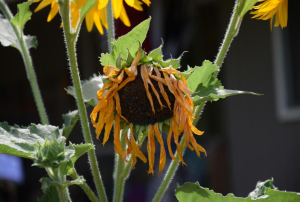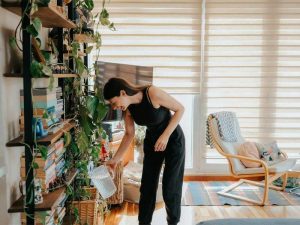Raise your hand if you've ever stared longingly at a droopy basil plant under your grow lights, wondering where you went wrong. (We've all been there).
Indoor gardening with LED lights and grow tents setup is a fantastic way to cultivate your own fresh herbs and veggies year-round, whether you're in the UK, Germany, or anywhere else in Europe.
But let's face it, those little green babies can be thirsty – and figuring out how much water they crave can feel like a guessing game. And if you get it wrong and ruin your harvest, well, it can feel incredibly demotivating.
That's why nailing your watering technique is absolutely crucial. It's the difference between vibrant, thriving plants and a disappointing harvest. The good news? With a few simple tips (and the right Mars Hydro gear!), you can transform your indoor garden into a lush oasis.
So, if you're ready to become a watering wizard, let's dive in.
Understanding Watering Needs Under LED Grow Lights
Your plants under those shiny LED grow lights aren't just basking in the glow – they're working hard to grow.
But here's the thing: their water needs can be a tad different than plants soaking up natural sunlight. After all, plant tissue comprises up to 95% water, so it's a fundamental you've got to nail.
So grow lights. LED lights produce less heat, meaning your soil might stay damp for longer. That's why it's important to find that sweet spot between too much and too little H₂O.
So, how often should you reach for the watering can? Well, it depends. (I know, I know—not the answer you were hoping for.)
The frequency and amount of water your plants need will vary based on a few key factors:
- Plant type:Some plants are naturally thirstier than others. Leafy greens might need more frequent watering than, say, succulents.
- Growth stage:Seedlings and young plants typically need less water than mature plants that are flowering or fruiting.
- Container size:Larger pots hold more moisture, meaning you might not need to water as often.
- Temperature and humidity:Higher temperatures and lower humidity can cause soil to dry out faster.
Now, how do you actually know when your plants are thirsty? Never guess, and you don't even need to. There are a few tried-and-true methods:
- The Finger Test:Stick your finger about an inch into the soil. If it feels dry, it's time to water. If it's still damp, hold off for a bit.
- Moisture Metres:For a more accurate reading, consider using a moisture metre. Mars Hydro has some excellent options available on its EU site (https://marshydro.eu/). These handy little gadgets take the guesswork out of watering and can save your plants from both underwatering and overwatering.
By paying attention to these factors and using the right tools, you'll be well on your way to becoming a watering pro!
Watering Methods for Optimal Growth
Alright, now you know when to water, let's talk about how. After all, not all watering methods are created equal. Here are a few techniques that work wonders in indoor grow tents:
- Top Watering:This classic method involves manually pouring water directly onto the soil surface. It's simple, but be careful not to overwater or splash water onto the leaves, which can lead to fungal issues.
- Bottom Watering:This technique involves placing your pots in a water tray and letting the soil absorb moisture from the bottom. It's great for promoting healthy roots, but it can be tricky to gauge how much water your plants take up.
- Drip Irrigation:If you're looking for a more automated solution, drip irrigation systems deliver water directly to the roots, minimising waste and ensuring consistent moisture levels.
And no matter which method you choose, remember these golden rules:
- Avoid Overwatering:Soggy soil is a recipe for root rot and other nasty problems. If you see water pooling on the surface or your plants look wilted despite moist soil, you're probably overdoing it.
- Avoid Underwatering:Dry, cracked soil is equally problematic. Your plants will start to droop, their leaves might turn yellow, and they'll be more susceptible to pests and diseases.
To strike the perfect balance, pay close attention to your plants' cues and adjust your watering schedule as needed. And don't forget that the seasons can play a role too! You might need to water more frequently in the warmer months and less often in winter.
By experimenting with different watering methods and finding what works best for your plants, you'll be well on your way to a thriving indoor garden.
Water Quality and pH
With all this in mind, let's take a moment to talk about the actual water you're using to water your plants. You might be thinking, "Water is water, right?" Not quite.
The quality of your water and its pH level can have a big impact on your plant's health and happiness. Think of it like this: your plants need to "drink" nutrients through their roots, but if the water isn't right, those nutrients won't be as readily available.
So, what kind of water should you be using?
- Tap Water:In many areas, tap water is excellent for plants. But if your water is heavily chlorinated or has high levels of minerals, it might be worth considering alternatives.
- Filtered or Purified Water:Using filtered or purified water can remove impurities that might harm your plants. You can buy filtered water or invest in a filtration system for your home.
- Rainwater:If you can collect it, rainwater is a fantastic option for plants. It's naturally soft and free of chemicals.
But that's not all! The pH of your water also matters. pH measures how acidic or alkaline the water is, and different plants have different pH preferences. Most plants thrive in a slightly acidic environment (pH 6.0-6.5), but some prefer a more neutral or alkaline pH.
It really depends on what you're growing, so look it up. The internet is a trove of information that can help here.
How do you figure out your water's pH? You can buy a pH metre (Mars Hydro has some great ones) or use pH test strips. If you need to adjust the pH, there are various pH up and pH solutions available.
It might sound a bit technical, but trust me, getting the water quality and pH right is worth the effort. Your plants will thank you with stronger growth and a more bountiful harvest.
Conclusion
So, there you have it! We've covered a lot of ground, from understanding your plants' unique watering needs under LED grow lights to choosing the right watering methods and ensuring your water quality is up to par.
Remember, mastering the art of watering takes practice and a little patience, but the rewards are oh-so-worth it.
By following these tips and investing in a few key Mars Hydro products, like their moisture metres and pH metres – all available online, you'll be well on your way to a thriving indoor garden bursting with flavourful herbs and veggies.
And hey, don't be afraid to experiment and find what works best for your specific setup and plants. Every garden is unique, just like every gardener.






